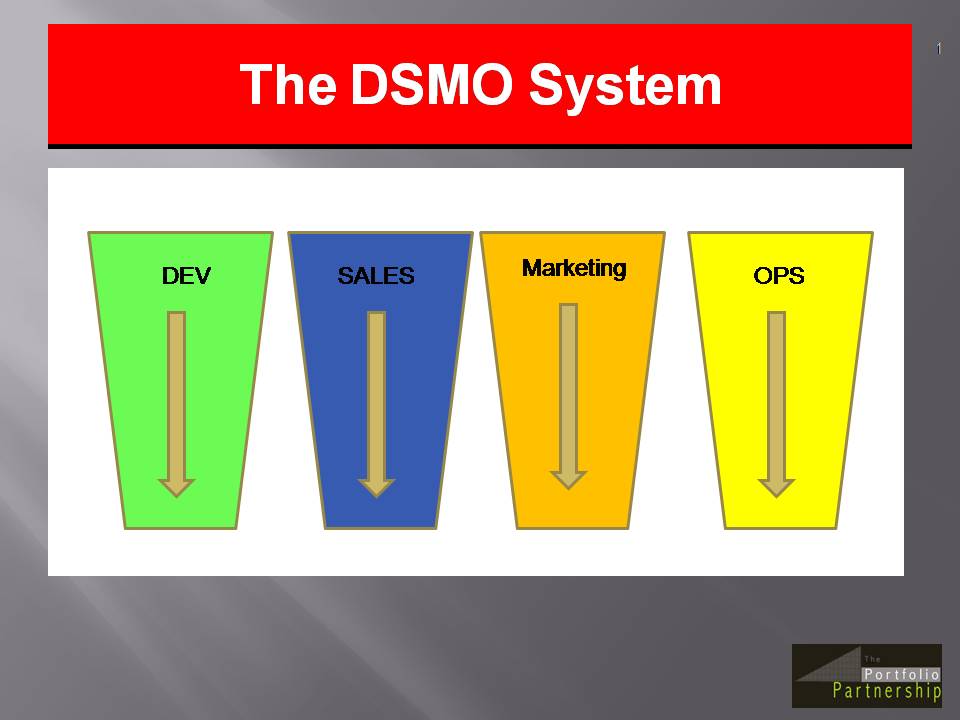“Intuit weren’t good at getting new products out to the customer” said newly appointed CEO Brad Smith in Jan 2008. A few years later on the back of a new R&D system (the first in the company’s 27 year history), sales are up and the number of features in the flagship product QuickBooks has doubled. The new system is based on small, agile teams sometimes as few as two people. So how do you beat the odds of launching new products that drive success. The secret is alignment. I believe there is a robust system and I call it the DSMO model. This stands for Development, Sales, Marketing and Operations. It ensures that when a product is launched the whole company is aligned behind it.
Lessons Learned from Launching Products
The key is to ensure that no one area gets ahead of itself. There is no point in a great product shipping on August 1st and then discovering the sales team are poorly trained. Or the operations team have no clear guidance on how to invoice the client or are unaware of the various pricing models. So creating parallel lines is the key with one overall project champion in charge and separate heads for each discipline; development, sales, marketing and operations. Here are some thoughts learned the hard way to keep your new products on track, with a great narrative, a great sales pipeline and over-serviced by your operations team.
- Build a funnel of great ideas from the ground up using customers, staff, partners, competitors, brainstorming sessions. Note I highly recommend getting real sales professionals in the room who actually talk to customers and understand their world.
- Be wary of ideas coming from developers who have never lived in a customer’s world, never experienced the symptoms you are about to treat.
- Use Basecamp or something similar to communicate often with the dev team. Highly recommend 2 week scrums to maximize productivity and minimize feature creep.
- Don’t train sales professionals too early ( they will talk about it to customers). But you must start training at least 3 weeks pre launch to allow then to build a pipeline/list of early adopters.
- Worry about a name for the new product as early as possible and do a comprehensive legal search of what is available. Otherwise you will end up with strange spellings with 4 xxxx to avoid confusion.
- Get marketing started on positioning the product against the competition. Define the business results that will be achieved and build a story around how customers will USE the product.
- Play with different pricing models and invoice methods involving the ops team. Wrestle with several models before deciding on the launch version.
- Ensure development works closely with marketing to build a great web site including self help videos and FAQs.
- Look at the complexity of features and usability not just through the lens of a prospect but also also your sales teams. Some products are built too complex to sell.
- Build guidance notes for demos for the sales teams and engineers. It’s theater, write a script. The most relaxed presenter has practiced 10 times for every real delivery.
- Be crystal clear on the audience/persona who will buy the product. Talk in their language not yours.Why does the product enhance their careers? Let the web site tell that story.
- The new product team needs to meet every 2 weeks with at least 5 attendees, the overall project manager, head of development, marketing manager, sales manager and the ops head. This will ensure that cross-silo issues are dealt with in a timely and efficient manner. Religious use of checklists with names and dates are mandatory. Again Basecamp has proved essential.
- Use milestones to ensure the launch date is on track. Think planes crash because of what happens at 10,000 feet not 1000 feet. If trajectories are wrong they need correcting early.
- Always simplify product features to get something real into the market. Validation is more important than perfection.
- Mimic how the product will operate within your portfolio of products long before launch date. Imagine how you will deal with the product life-cycle in terms of capacity, storage, servicing.
- Build momentum towards a date ensuring that the final product (at least the first version) is consistent with the narrative and processes created in sales, marketing and ops.








